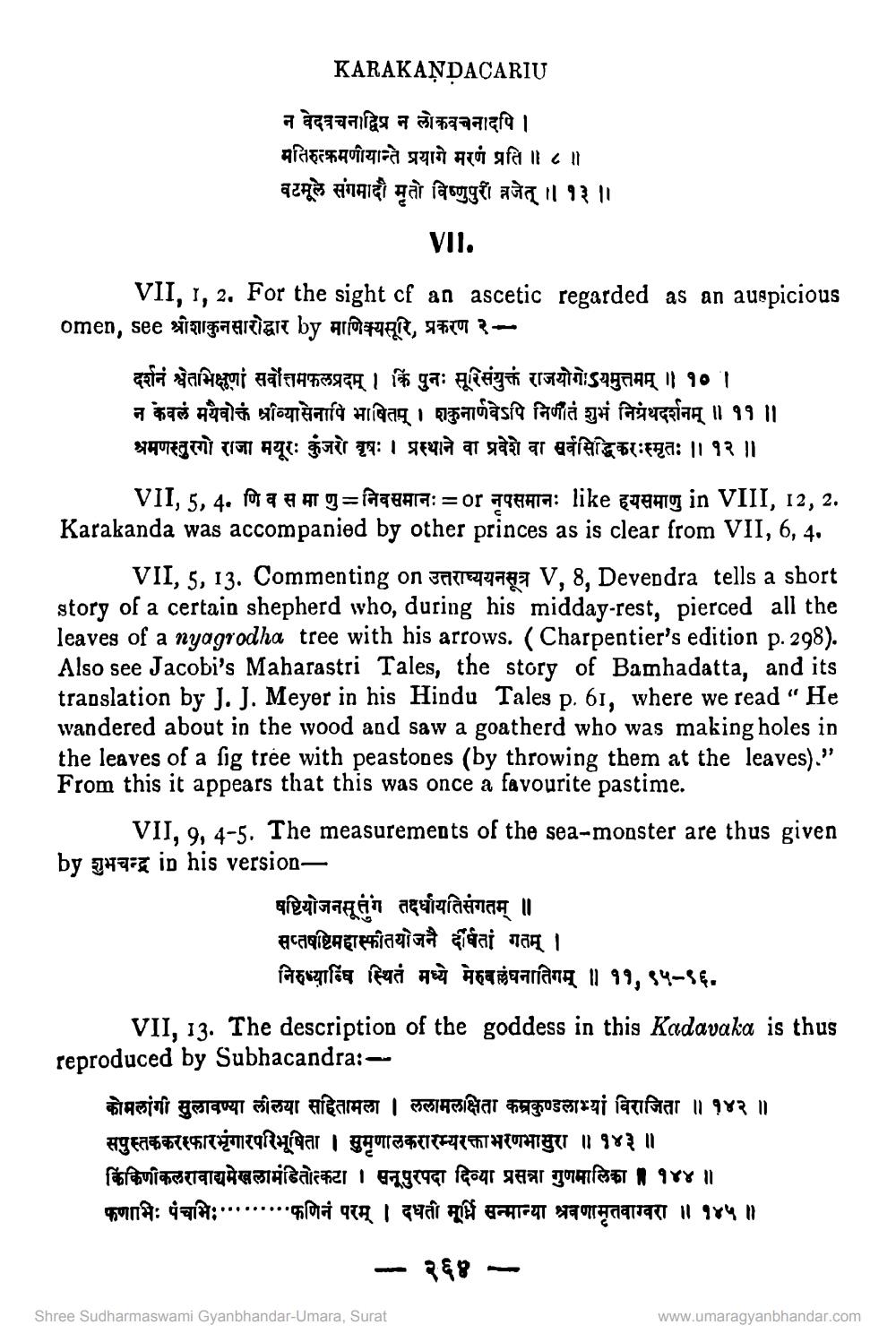________________
KARAKAŅDAÇARIU न वेदवचनाद्विप न लोकवचनादपि । मतिरुत्क्रमणीयान्ते प्रयागे मरणं प्रति ॥ ८ ॥ वटमूले संगमादौ मृतो विष्णुपुरी नजेत् ॥ १३ ॥
VII.
VII, 1, 2. For the sight cf an ascetic regarded as an auspicious omen, see श्रीशाकुनसारोद्धार by माणिक्यसूरि, प्रकरण २
दर्शनं श्वेतभिक्षणां सर्वोत्तमफलप्रदम् । किं पुनः सूरिसंयुक्तं राजयोगोऽयमुत्तमम् ॥ १० ॥ न केवलं मयैवोक्तं श्रीव्यासेनापि भाषितम् । शकुनार्णवेऽपि निणीतं शुभं निग्रंथदर्शनम् ॥ ११ ॥ श्रमणस्तुरगो राजा मयूरः कुंजरो वृषः । प्रस्थाने वा प्रवेशे वा सर्वसिद्धिकरःस्मृतः ।। १२ ॥
VII, 5, 4. णि व स मा णु = निवसमानः = or नपसमानः like हयसमाणु in VIII, I2, 2. Karakanda was accompanied by other princes as is clear from VII, 6, 4.
VII, 5, 13. Commenting on उत्तराध्ययनसूत्र V, 8, Devendra tells a short story of a certain shepherd who, during his midday-rest, pierced all the leaves of a nyagrodha tree with his arrows. (Charpentier's edition p. 298). Also see Jacobi's Maharastri Tales, the story of Bamhadatta, and its translation by J. J. Meyer in his Hindu Tales p. 61, where we read “He wandered about in the wood and saw a goatherd who was making holes in the leaves of a sig tree with peastones (by throwing them at the leaves).” From this it appears that this was once a favourite pastime.
___VII, 9,4-5. The measurements of the sea-monster are thus given by शुभचन्द्र in his version
षष्टियोजनसूतंग तदर्धायतिसंगतम् ॥
सप्तषष्टिमहास्फीतयोजनै दर्षितां गतम् ।
निरुभ्याधि स्थितं मध्ये मेरुवल्लंघनातिगम् ॥ ११,९५-९६. VII, 13. The description of the goddess in this Kadavaka is thus reproduced by Subhacandra:
कोमलांगी सुलावण्या लीलया सहितामला । ललामलक्षिता कम्रकुण्डलाभ्यां विराजिता ॥ १४२ ॥ सपुस्तककरस्फार,गारपरिभूषिता । सुमृणालकरारम्यरक्ताभरणभासुरा ॥ १४३ ॥ किंकिणीकलरावायमेखलामंडितोत्कटा । सनूपुरपदा दिव्या प्रसन्ना गुणमालिका ॥ १४ ॥ फणाभिः पंचभिः......... फणिनं परम् । दधती मूर्तीि सन्मान्या श्रवणामृतवाग्वरा ॥ १४५॥
Shree Sudharmaswami Gyanbhandar-Umara, Surat
www.umaragyanbhandar.com




